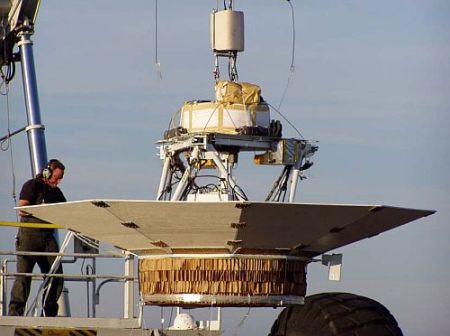Purpose of the flight and payload description
This test series was the first in a program of three test series designed to develop a new parachute system for Mars exploration as starting the new century, many of the lander missions under consideration included payloads that were five times more massive than those of previous missions. The program was carried out by the the Jet Propulsion laboratory, California Institute of Technology and Pioneer Aerospace with the support of NASA's National Scientific Balloon Facility.
The approach adopted instead of developing and qualifying a new system for these missions was to perform balloon-based drop tests of a 33.5 m Ringsail Canopy subsonic parachute to be used in conjunction with the existing supersonic Viking parachute as part of a two-stage system. The reason to use stratospheric balloons to tests this new design is based in the fact that in general, the atmospheric density near Mars surface is equivalent to Earth densities at altitudes between 30 and 35 km. The gondola plus canopy mass flown in these tests were 980 kg which corresponds to a Mars system mass of about 2500 kg.
At left we can see an image of the gondola used for the tests (click for more details). It was a simple truss structure that included a faceted aerodynamic fairing to produce an aerodynamic wake similar to that expected from a hypersonic entry capsule of diameter of about 3.5 meters. The fairing assured the parachute inflated and operated in wake conditions similar to those expected on Mars. The structural base of the gondola was a 2.54 cm thick steel regular nonagon (a nine sided polygon with equal sides) with paper honeycomb crush pads mounted for ground impact energy absorption. On top of this base plate the batteries, instrumentation, pyrotechnics, and balloon telecommunications equipment were mounted. Bipod trusses connected the base plate to three structural nodes at the parachute deck above. Both the drogue triple risers and the main triple risers were attached to these structural nodes. The main ringsail canopy was stowed in an annular deployment bag on the parachute deck and the smaller drogue deployment bag was stored on top of the main. Staging of the main parachute was commanded by a pyrotechnics system on the Gondola. Cuting wires in the gondola released cutters activated timers in the on-board pyrotechnics system. When these timers expired, they commanded cutters at each structural node that simultaneously severed the three drogue triple risers.
The gondola carried four cameras: three up-looking cameras to observe the deployment and operation of the drogue and main canopies, one horizon looking camera, and one down-looking camera. The later was part of a separate experiment dedicated towards obtaining visual imagery for optical navigation of a pin-point landing technology task. Additional imagery was collected via a ground-based telescope fitted with a video camera and another video camera in the chase airplane.
The instrumentation suite included numerous sensors to record the deployment, inflation, and inflated performance of the parachute. All data was stored by an on-board, low power CPU with flash memory storage. The memory capacity (and Lithium-ion battery power supply) was sized for a 10 hour duration. This time accounted for potential delays in launch, or extended period at float while an acceptable descent corridor was found.
A Northrop Grumman LN-200 Inertial Measurement Unit included 3-axis accelerometers and 3-axis rate gyros for obtaining detailed data on gondola dynamics. Load cells were mounted in-line on each of the main parachute triple risers. In addition to providing a direct measurement of inflation loads, the load cells could describe the motion of the parachute relative to the gondola. A Global Positioning System (GPS) receiver and antennae were included to provide rough trajectory and altitude information. Five pressure transducers and numerous temperature transducers were also included.
Details of the balloon flight
Balloon launched on: 10/21/2004 at 14:23 utc
Launch site: Scientific Flight Balloon Facility, Fort Sumner, (NM), US
Balloon launched by: National Scientific Balloon Facility (NSBF)
Balloon manufacturer/size/composition: Zero Pressure Balloon Winzen - 11.820.000 cuft (0.8 mil) - SF3-11.83-.8/.8-NHR
Balloon serial number: W11.82-1E-29
Flight identification number: 536N
End of flight (L for landing time, W for last contact, otherwise termination time): 10/21/2004 at 15:20 utc
Landing site: 22 miles ENE of Tucumcari, New Mexico, US
This was the third test in the series. The balloon was launched from the Scientific Flight Facility in Fort Sumner, New Mexico on October 21, 2004. Again launch preparations and launch proceeded as expected. However, as the balloon ascended through 18.3 km altitude it burst. The NSBF recovery parachute inflated as designed and the gondola was brought safely to the ground. The test canopies were not deployed, however, they were on board the Gondola during the ensuing 18 m/s ground impact which subjected the packed canopies to ~20 g impact loads. This impact raised concerns over potential damage to the packed canopy.
Numerous risks were identified associated with reflight of the canopy without inspection and repack. The primary risk discussed was friction damage to the canopy structure, but other risks identified included the possibility that the reefing cutters had been triggered (Lanyard pull) and fired following impact. This risk was judged to be unlikely given the orientation and dense packing of the cutter regions. The repack option would have delayed the test some two weeks and probably prevented a fourth test in the Fall 2004 campaign. The program made the decision to accept the risks and re-fly the canopy four days later with only an inspection of its attachment to the Gondola.
External references
- High Altitude Test Program for A Mars Subsonic Parachute 18th AIAA Aerodynamic Decelerator Systems Technology Conference and Seminar
695If you consider this website interesting or useful, you can help me to keep it up and running with a small donation to cover the operational costs. Just the equivalent of the price of a cup of coffee helps a lot.


